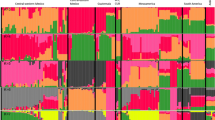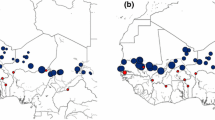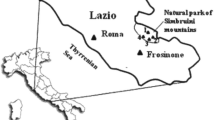Abstract
Despite the evolutionary, ecological and economic importance of introgression between a domesticated species and its wild relatives in centers of diversity and domestication, the role of traditional farmers in this process has received limited attention. In the Yucatan Peninsula, the region of Mexico that has the greatest amount of domesticated varieties of Lima bean, wild populations grow sympatrically with conspecific varieties, allowing the Mayan farmer to act directly on introgressed seed. We used 11 microsatellite loci to assess levels of introgression in three wild-domesticated complexes of Lima bean from the Yucatan Peninsula and analyze its impact on the genetic diversity of this crop. structure and InStruct analyses showed similar results. The Instruct analysis indicated that the complex with the lowest level of introgression was one where the farmer actively selected against wild plants and introgressed seed. In contrast, the complex with the highest level of introgression was one where the farmer has been consciously selecting a weedy morphotype for 15 years and has already incorporated it into his diet. Genetic diversity of the domesticated pool was higher in the complex with the higher level of introgression. This study showed that farmers have an important role in limiting or favoring the wild to crop introgression and influencing the levels of genetic diversity in their domesticated pool. Only when traditional farmers’ knowledge is taken into account can we correctly understand the dynamics, generation and maintenance of genetic diversity of the landraces in the centers of diversity and domestication.



Similar content being viewed by others
References
Altieri MA, Montecinos C (1993) Conserving crop genetic resources in Latin America through farmer’s participation. In: Christopher S, Potter DJ, Cohen JI (eds) Perspectives on biodiversity: case studies of genetic resource conservation and development. American Association for the Advancement of Science, Washinton, pp 45–64
Anderson E (1949) Introgressive hybridization. Wiley, New York
Andueza-Noh RH, Serrano-Serrano ML, Chacón Sánchez MI, Sánchez del Pino I, Camacho-Pérez L, Coello-Coello J, Mijangos Cortés J, Debouck DG, Martínez-Castillo J (2013) Multiple domestications of the Mesoamerican gene pool of Lima bean (Phaseolus lunatus L.): evidence from chloroplast DNA sequences. Genet Resour Crop Evol 60:1069–1086
Arnold ML (1992) Natural hybridization as an evolutionary process. Ann Rev Ecol Syst 23:237–261
Ballesteros GA (1999) Contribuciones al conocimiento del frijol Lima (Phaseolus lunatus L.) en América Tropical. PhD Thesis, Colegio de Posgraduados. Montecillos, Estado de México
Bañuelos-Jimenes JS, Craig R, Lynch JP (2002) Salinity tolerance of species during germination and early seedling growth. Crop Sci 42:1584–1594
Barnaud A, Deu M, Garine E, Chantereau J, Bolteu J, Koïda EO, McKey D, Joly HI (2009) A weed–crop complex in sorghum: the dynamics of genetic diversity in a traditional farming system. Am J Bot 96(10):1869–1879
Barrantes D, Macaya G, Guarino L, Baudoin JP, Rocha OJ (2008) The impact of local extinction on genetic structure of wild populations of Lima beans (Phaseolus lunatus) in the Central Valley of Costa Rica: consequences for the conservation of plant genetic resources. Rev Biol Trop 56(3):1023–1041
Baudet JC (1977) The taxonomic status of the cultivated types of Lima bean (Phaseolus lunatus L.). Trop Grain Legume Bull 7:29–30
Baudoin JP, Degreef J, Hardy O, Janart F, Zoro Bi I (1998) Development of an in situ conservation strategy for wild Lima bean (Phaseolus lunatus L.) populations in the central valley of Costa Rica. In: Owens SJ, Rudall PJ (eds) Reproduction biology. Royal Botanic Garden Press, Kew, pp 417–426
Beebe S, Toro O, Viviana G, Chacón MI, Debouck DG (1997) Wild-weed-crop complexes of common bean (Phaseolus vulgaris L., Fabaceae) in the Andes of Peru and Colombia, and their implications for conservation and breeding. Genet Resour Crop Evol 44:73–91
Bitterlich I, Upadhyaya MK, Shibairo SI (1996) Weed control in cole and onion (Allium cepa) crops using ammonium nitrate. Weed Sci Soc Am 44:952–958
Brush SB (1995) In-situ conservation of landraces in centers of crop diversity. Crop Sci 35:346–354
Chandler S, Dunwell JM (2008) Gene flow, risk assessment and the environmental release of transgenic plants. Crit Rev Plant Sci 27(1):25–49
Chimal-Chan AM (2008) Polinización y flujo génico de Phaseolus lunatus L. en el sur de la Península de Yucatán. Bachelor Dissertation. Instituto Tecnológico de Conkal. Conkal, Yucatán, México
CIRAD (2002) Coconut Microsatellite kit (A loboratory Manual), Training session. Montpellier, France
Cortés AJ, Monserrate FA, Ramírez-Villegas J, Madriñán S, Blair MW (2013) Drought tolerance in wild plant populations: the case of common bean (Phaseolus vulgaris L.). PLoS ONE 8(5):e62898. doi:10.1371/journal.pone.0062898
Coulibaly S, Pasquet RS, Papa R, Gepts P (2002) AFLP analysis of the phenetic organization and genetic diversity of Vigna unguiculata L. Walp. Reveals extensive gene flow between wild and domesticated types. Theor Appl Genet 104:358–366
Couturon E, Mariac C, Bezançon G, Lauga L, Renno JF (2003) Impact of natural and human selection on the frequency of the F1 hybrid between cultivated and wild pearl millet (Pennisetum glaucum (L.) R. Br.). Euphytica 133:329–337
Cuanalo de la C. HE, Arias-Reyes LM (1997) Cultural and economic factors that affect farmers decision-making in Yucatan, Mexico. Pág. 14 In: DI Jarvis, T Hodgkin (ed), Strengthening the scientific basis of in situ conservation of agricultural biodiversity on-farm. Options for data collecting and analysis. Workshop 25–29 Aug. 1997. IPGRI, Rome, Italy
Degreef J (1998) De´veloppement d’un mode `le de ´mographicque et applications a ` la conservation in situ de populations sauvages de haricot de Lima (Paseoulus lunatus L.) dans la valle ´e centrale du Costa Rica. PhD Thesis, Fac Univ Sci Agron. Gembloux, Belgium
Desplanque B, Boudry P, Broomberg K, Saumitou-Laprade P, Cuguen J, Van Dijk H (1999) Genetic diversity and gene flow between wild, cultivated and weedy forms of Beta vulgaris L. (Chenopodiaceae), assessed by RFLP and microsatellite markers. Theor Appl Genet 98:1194–1201
Doyle J, Doyle J (1987) A rapid DNA isolation procedure for small quantities of fresh leaf tissue. Phytochem Bull 19:11–15
Duputié A, David P, Debain C, McKey D (2007) Natural hybridization between a clonally propagated crop, cassava (Manihot esculenta Crantz) and a wild relative in French Guiana. Mol Ecol 16:3025–3038
Ejeta G, Grenier C (2005) Sorghum and its weedy hybrids. In: Gressel J (ed) Crop ferality and volunteerism. Taylor and Francis, Boca Raton, pp 123–135
Elias M, McKey D, Panaud O, Anstett MC, Robert T (2001) Traditional management of cassava morphological and genetic diversity by the Makushi Amerindians (Guyana, South America): perspectives for on-farm conservation of crop genetic resources. Euphytica 120:143–157
Ellstrand NC, Prentice HC, Hancock JF (1999) Gene flow and introgression from domesticated plants into their wild relatives. Ann Rev Ecol Syst 30:539–563
Evanno G, Regnaut S, Goudet J (2005) Detecting the number of clusters of individuals using the software STRUCTURE: a simulation study. Mol Ecol 14:2611–2620
Excoffier L, Smouse P, Quattro J (1992) Analysis of molecular variance inferred from metric distance among DNA haplotypes: applications to human mitochondrial DNA restriction data. Genetics 131:479–491
Gaitán-Solís E, Duque MC, Edwards KJ, Tohme J (2002) Microsatellite repeats in common bean (Phaseolus vulgaris): isolation, characterization, and cross-species amplification in Phaseolus ssp. Crop Sci 42:2128–2136
Gao H, Williamson S, Bustamante CD (2007) An MCMC approach for joint inference of population structure and inbreeding rates from multi-locus genotype data. Genetics 176:1635–1651
Gepts P, Papa R (2003) Possible effects of (trans)gene flow from crops on the genetic diversity from landraces and wild relatives. Environ Biosaf Res 2:89–103
Grant V (1981) Plant speciation, 2nd edn. Columbia University Press, New York
Gray AJ (2005) Hybridization between crops and wild plants in the age of genetic engineering: new risks or new paradigms? Am J Bot 92(4):768–771
Hajjar R, Hodgkin T (2007) The use of wild relatives in crop improvement: a survey of developments over the last 20 years. Euphytica 156:1–13
Harlan JR (1965) The possible role of weedy races in the evolution of cultivated plants. Euphytica 14:173–176
Hernández-Xolocotzi E (1959) La agricultura. In: Beltrán E (ed) Los recursos naturales del sureste y su aprovechamiento, vol 3. Instituto Mexicano de Recursos Naturales Renovables, México, pp 1–38
Jakobsson M, Rosenberg NA (2007) CLUMPP: a cluster matching and permutation program for dealing with label switching and multimodality in analysis of population structure. Bioinformatics 23:1801–1806
Jarvis D (1999) Strengthening the scientific basis of in situ conservation of agricultural biodiversity on farm. Bot Lithuania 2(Suppl):79–90
Jarvis DI, Hodgkin T (1999) Wild relatives and crop cultivars: detecting natural introgression and farmer selection of new genetic combinations in agroecosystems. Mol Ecol 8:159–173
Kalinowski ST (2005) HP-Rare: a computer program for performing rarefaction on measures of allelic diversity. Mol Ecol Notes 5:187–189
Lakis G, Ousmane A, Sanoussi D, Habibou A, Badamassi M, Lamy F, Jika N, Sidikou R, Adam T, Sarr A, Luxereau A, Robert T (2011) Evolutionary dynamics of cycle length in pear millet: the role of farmer’s practices and gene flow. Genetica 139:1367–1380
Mariac C, Robert T, Allinne C, Remigereau MS, Luxereau A, Tidjani M, SeyniO Bezancon G, Pham JL, Sarr A (2006) Genetic diversity and gene flow among pearl millet crop/weed complex: a case study. Theor Appl Genet 113:1003–1014
Martínez-Castillo J, Zizumbo-Villarreal D, Perales-Rivera H, Colunga-GarcíaMarín P (2004) Intraspecific diversity and morpho-phenological variation in Phaseolus lunatus L. from the Yucatan Peninsula, México. Econ Bot 58(3):354–380
Martínez-Castillo J, Zizumbo-Villarreal D, Gepts P, Delgado-Valerio P, Colunga-GarcíaMarín P (2006) Structure and genetic diversity of wild populations of lima BEAN (Phaseolus lunatus L.) from the Yucatan Peninsula, Mexico. Crop Sci 46:1071–1080
Martínez-Castillo J, Zizumbo-Villarreal D, Gepts P, Colunga-GarcíaMarín P (2007) Gene flow and genetic structure in the wild-weedy-domesticated complex of Lima bean (P. lunatus L.) in its Mesoamerican center of domestication and diversity. Crop Sci 47:58–66
Martínez-Castillo J, Colunga-GarcíaMarín P, Zizumbo-Villarreal D (2008) Genetic erosion and in situ conservation of Lima bean (Phaseolus lunatus L.) landraces in its Mesoamerican diversity center. Genet Resour Crop Evol 55:1065–1077
Martínez-Castillo J, Camacho-Pérez L, Coello-Coello J, Andueza-Noh R (2011) Wholesale replacement of Lima bean (Phaseolus lunatus L.) landraces over the last 30 years in northeastern Campeche, Mexico. Genet Resour Crop Evol 59:191–204
Matsuoka Y, Vigouroux Y, Goodman MM, Sanchez GJ, Buckler I, Doebley JF (2002) A single domestication for maize shown by multilocus microsatellite genotyping. Proc Natl Acad Sci USA 99:6080–6084
Motta-Aldana J, Serrano-Serrano ML, Torres HJ, Villamizar CG, Debouck DG, Chacón MI (2010) Multiple origins of lima bean landraces in the Americas: evidence from chloroplast and nuclear DNA polymorphisms. Crop Sci 50:1773–1787
Olsen K, Schaal B (2007) Insights on the evolution of a vegetatively propagated crop species. Mol Ecol 16:2838–2840
Papa R, Gepts P (2003) Asymmetry of gene flow and differential geographical structure of molecular diversity on wild and domesticated common bean (Phaseolus lunatus L.) from Mesoamerica. Theor Appl Genet 106:239–250
Papa R, Acosta J, Delgado-Salinas A, Gepts P (2005) A genome-wide analysis of differentiation between wild and domesticated Phaseolus vulgaris from Mesoamerica. Theor Appl Genet 111:1147–1158
Pérez-Toro A (1945) La agricultura milpera de los mayas de Yucatán. pp 173–204. In: LH Hoyos Villanueva, R Irigoyen-Rosado, R Ruz-Menéndez, H Lara-Lara (eds), Enciclopedia Yucatanense. Edición Oficial del Gobierno del Estado de Yucatán Vol. 6. México
Pilson D, Prendeville RHR (2004) Ecological effects of transgenic crops and the escape of transgenes into wild populations. Annu Rev Ecol Evol Syst 35:149–174
Pritchard JK, Stephens M, Donnelly P (2000) Inference of population structure using multilocus genotype data. Genetics 155:945–959
Pujol B, David P, McKey D (2005) Microevolution in agri-cultural environments: how a traditional Amerindian farming practice favours heterozygosity in cassava (Manihot esculenta Crantz, Euphorbiaceae). Ecol Lett 8:138–147
Quiros CF, Ortega R, Van Raamsdonk LWD (1992) Amplification of potato genetic resources in their center of diversity: the role of natural outcrossing and selection by the Andean farmer. Genet Resour Crop Evol 39:107–113
Rhymer JM, Simberloff D (1996) Extinction by hybridization and introgression. Annu Rev Ecol Evol Syst 27:83–109
Rosenberg NA (2002) Distruct: a program for the graphical display of structure results. http://www.cmb.usc.edu/»noahr/distruct. Accessed 1 Sept 2013
Scarcelli N, Tostain S, Vigouroux Y (2006) Farmers’ use of wild relative and sexual reproduction in a vegetatively propagated crop. The case of yam in Benin. Mol Ecol 15:2421–2431
Schneider S, Roessli D, Excoffier L (2000) Arlequin ver. 2.000: a software for population genetics data analysis. Genetics and Biometry Laboratory, University of Geneva, Switzerland
Serrano-Serrano ML, Hernández-Torres J, Castillo-Villamizar G, Debouck DG, Chacón MI (2010) Gene pools in wild Lima bean (Phaseolus lunatus L.) from the Americas: evidences for an Andean origin and past migrations. Mol Phylogenet Evol 54:76–87
Serrano-Serrano ML, Andueza-Noh RH, Martínez-Castillo J, Debouck DG, Chacón MI (2012) Evolution and domestication of Lima bean (Phaseolus lunatus L.) in Mexico: evidence from ribosomal DNA. Crop Sci 52:1698–1712
Slatkin M (1987) Gene flow and the geographic structure of natural populations. Science 236:787–792
StatPoint, Inc. (2006) Statgraphics Centurión XV. Version 15.2.05 1982–2007
Suárez-Barón H, Martínez-Garay C, Gonzalez-Torres RI, Duque MC, Debouck DG, Thome J (2007) Determination of gene flow events in natural “wild-weedy-cultivated complexes in gene pools of Phaseolus lunatus L. External Program and Management Reviews (EPMRs). CIAT Colombia
Tautz D (1989) Hypervariability of simple secuence as a general source for polymorphic DNA markers. Nucleic Acids Res 17:6463–6471
Teshome A, Baum BR, Fahrig L, Torrance JK, Arnasen TJ, Lambert JH (1997) Sorghum (Sorghum bicolor L.) landrace variation and classification in north Shewa and South Welo, Ethiopia. Euphytica 97:255–263
Van Oosterhout C, Hutchinson WF, Wills DPM, Shipley P (2004) MICRO-CHECKER: software for identifying and correcting genotyping errors in microsatellite data. Mol Ecol Notes 4:535–538
Van Raamsdonk LWD, Van Der Maesen LJG (1996) Crop-weed-complexes: the complex relationship between crop plants and their wild relatives. Acta Botánica Neerlandica 45:135–155
Viard F, Bernard J, Desplanque B (2002) Crop–weed interactions in the Beta vulgaris complex at a local scale: allelic diversity and gene flow within sugar beet fields. Theo App Genet 104:688–697
Vigouroux Y, McMullen M, Hittinger CT, Houchins K, Schulz L, Kresovich S, Matsuoka Y, Doebley J (2002) Identifying genes of agronomic importance in maize by screening microsatellites for evidence of selection during domestication. PNAS 99:9650–9655
Vijayan P, Parkin IA, Karcz SR, McGowan K, Vijayan K, Vandenberg A, Bett KE (2011) Captured cold-stress-related sequences diversity from a wild relative of common bean (Phaseolus angustissimus). Genome 54:620–628
Webster BD, Lynch SP, Tucker CL (1979) A morphological study of the development of reproductive structures of Phaseolus lunatus L. J Am Soc Hortic Sci 104:240–243
Xu DH, Abe J, Gai JY, Shimamoto Y (2002) Diversity of chloroplast DNA SSRs in wild and cultivated soybeans: evidence for multiple origins of cultivated cultivated soybeans. Theor Appl Genet 105:645–653
Yeh FC, Boyle TJB (1999). Popgene version 1.31. Microsoft window-based freeware for population analysis. University of Alberta and Centre for International Forestry Research, Edmonton, Alberta
Zizumbo-Villarreal D, Colunga-GarcíaMarín P, Payro E, Delgado-Valerio P, Gepts P (2005) Population structure and evolution dynamics of wild-weedy-domesticated complexes of common bean in a Mesoamerican region. Crop Sci 45:1073–1083
Acknowledgments
This paper is part of the research for the first author’s Master’s thesis at the Centro de Investigación Científica de Yucatán, A. C., postgraduate studies in Biological Sciences Option Natural Resources, conducted under the direction of Jaime Martínez-Castillo. We thank Patricia Colunga-GarcíaMarín, Daniel Zizumbo-Villarreal and Silvia Terán-Contreras for academic advice, and two anonymous reviewers for comments that improved the manuscript. The first author thanks the Consejo Nacional de Ciencia y Tecnología-Mexico for a scholarship for his postgraduate studies and Ciencia Básica-CONACYT (project number 54788) for financial support for the research. The authors thank B. Hazen for help reviewing the English.
Author information
Authors and Affiliations
Corresponding author
Rights and permissions
About this article
Cite this article
Félix, DT., Coello-Coello, J. & Martínez-Castillo, J. Wild to crop introgression and genetic diversity in Lima bean (Phaseolus lunatus L.) in traditional Mayan milpas from Mexico. Conserv Genet 15, 1315–1328 (2014). https://doi.org/10.1007/s10592-014-0619-7
Received:
Accepted:
Published:
Issue Date:
DOI: https://doi.org/10.1007/s10592-014-0619-7




